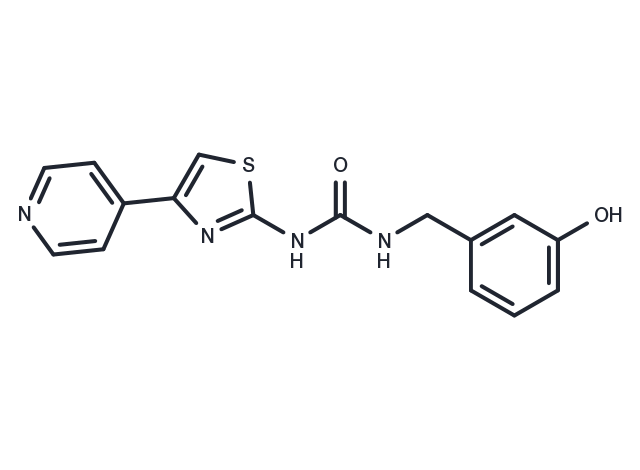Powder: -20°C for 3 years | In solvent: -80°C for 1 year


RKI-1447 is a potent inhibitor of ROCK1 and ROCK2. It has anti-invasive and antitumor activities.

| Pack Size | Availability | Price/USD | Quantity |
|---|---|---|---|
| 5 mg | In stock | $ 47.00 | |
| 10 mg | In stock | $ 89.00 | |
| 25 mg | In stock | $ 197.00 | |
| 50 mg | In stock | $ 328.00 | |
| 100 mg | In stock | $ 435.00 | |
| 200 mg | In stock | $ 548.00 | |
| 500 mg | In stock | $ 885.00 | |
| 1 mL * 10 mM (in DMSO) | In stock | $ 52.00 |








| Description | RKI-1447 is a potent inhibitor of ROCK1 and ROCK2. It has anti-invasive and antitumor activities. |
| Targets&IC50 | ROCK1:14.5 nM, ROCK2:6.2 nM |
| In vitro | RKI-1447 inhibits the growth of 87% of breast tumors, reducing the average volume of breast tumors by 7.7 times compared to the control mice. In a transgenic mouse model, RKI-1447 effectively suppresses breast tumor growth. When tumors in mice are treated with RKI-1447, the average percentage increase in tumor volume is only 8.8%. |
| In vivo | RKI-1447 inhibits the phosphorylation of ROCK substrates MLC-2 and MYPT-1 in human cancer cells, without affecting the phosphorylation levels of AKT, MEK, and S6 kinases at concentrations up to 10 μM. It suppresses the migration, invasion, and anchorage-independent growth of breast cancer cells. The crystal structure of the RKI-1447/ROCK1 complex reveals that RKI-1447 is a type I kinase inhibitor, binding to the ATP site through interactions with the hinge region and DFG motif. |
| Kinase Assay | Z-Lyte FRET kinase assay: Kinase inhibition is measured using the Invitrogen Z-Lyte? FRET kinase assay with Ser/Thr 13 peptide substrate based on the myosin light chain sequence KKRPQRRYSNVF. Compounds are tested on three separate days with 8 point dilutions performed in duplicate to determine average IC50 values. The assay conditions are optimized to 15 μL of kinase reaction volume with 5 ng of enzyme in 50 mM HEPES (pH 7.5), 10 mM MgCl2, 1 mM EGTA, and 0.01% Brij-35. The reaction is incubated for 1 h at room temperature in the presence of 1.5 μM of peptide substrate with 12.5 μM of ATP (for ROCK1) or 2 μM of substrate with 50 μM of ATP (for ROCK2). The reaction is then stopped and the ratio of phosphorylated to unphosphorylated peptides is determined by selective cleavage of only the unphosphorylated peptide as described by the manufacturer. This is followed by excitation of coumarin at 400 nm resulting in emission at 445 nm and energy transfer to fluorescein and final emission at 520 nm. The substrate contains both coumarin and fluorescein and only uncleaved phosphorylated substrate will undergo FRET. The ratio of the signals at 445 nm and 520 nm is measured using a Wallac EnVision Plate Reader, model 2102 plate-reader. |
| Cell Research | Cells are plated in a 96 well tissue culture plate (1200 cells per well) and incubated for 24 hours. After incubation the cells are treated with vehicle or increasing concentrations of RKI-1447 for 72 hours. After incubation, freshly prepared MTT (2 mg/ml) is added to each well and incubated for 3 hours. After incubation the plates are read at 540 nm. (Only for Reference) |
| Synonyms | RKI1447 |
| Molecular Weight | 326.37 |
| Formula | C16H14N4O2S |
| CAS No. | 1342278-01-6 |
Powder: -20°C for 3 years | In solvent: -80°C for 1 year
DMSO: 60 mg/mL (183.8 mM)
H2O: < 1 mg/mL (insoluble or slightly soluble)
Ethanol: < 1 mg/mL (insoluble or slightly soluble)
You can also refer to dose conversion for different animals. More
bottom
Please see Inhibitor Handling Instructions for more frequently ask questions. Topics include: how to prepare stock solutions, how to store products, and cautions on cell-based assays & animal experiments, etc.
RKI-1447 1342278-01-6 Cell Cycle/Checkpoint Cytoskeletal Signaling Stem Cells ROCK Rho-kinase Inhibitor inhibit ROK Rho-associated kinase RKI1447 Rho-associated protein kinase RKI 1447 inhibitor
